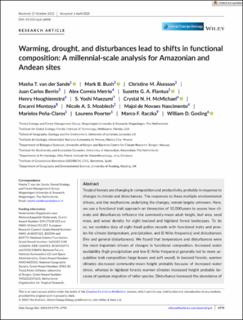Warming, drought, and disturbances lead to shifts in functional composition: A millennial-scale analysis for Amazonian and Andean sites
van der Sande, Masha T.; Bush, Mark B.; Åkesson, Christine M.; Berrio, Juan Carlos; Correia Metrio, Alex; Flantua, Suzette; Hooghiemstra, Henry; Maezumi, S. Yoshi; McMichael, Crystal N. H.; Montoya, Encarni; Mosblech, Nicole A. S.; de Novaes Nascimento, Majoi; Peña-Claros, Marielos; Poorter, Lourens; Raczka, Marco F.; Gosling, William D.
Journal article, Peer reviewed
Published version

View/
Date
2023Metadata
Show full item recordCollections
- Department of Biological Sciences [2232]
- Registrations from Cristin [9766]
Abstract
Tropical forests are changing in composition and productivity, probably in response to changes in climate and disturbances. The responses to these multiple environmental drivers, and the mechanisms underlying the changes, remain largely unknown. Here, we use a functional trait approach on timescales of 10,000 years to assess how climate and disturbances influence the community-mean adult height, leaf area, seed mass, and wood density for eight lowland and highland forest landscapes. To do so, we combine data of eight fossil pollen records with functional traits and proxies for climate (temperature, precipitation, and El Niño frequency) and disturbances (fire and general disturbances). We found that temperature and disturbances were the most important drivers of changes in functional composition. Increased water availability (high precipitation and low El Niño frequency) generally led to more acquisitive trait composition (large leaves and soft wood). In lowland forests, warmer climates decreased community-mean height probably because of increased water stress, whereas in highland forests warmer climates increased height probably because of upslope migration of taller species. Disturbance increased the abundance of acquisitive, disturbance-adapted taxa with small seeds for quick colonization of disturbed sites, large leaves for light capture, and soft wood to attain fast height growth. Fire had weak effects on lowland forests but led to more stress-adapted taxa that are tall with fast life cycles and small seeds that can quickly colonize burned sites. Site-specific analyses were largely in line with cross-site analyses, except for varying site-level effects of El Niño frequency and fire activity, possibly because regional patterns in El Niño are not a good predictor of local changes, and charcoal abundances do not reflect fire intensity or severity. With future global changes, tropical Amazonian and Andean forests may transition toward shorter, drought- and disturbance-adapted forests in the lowlands but taller forests in the highlands.
